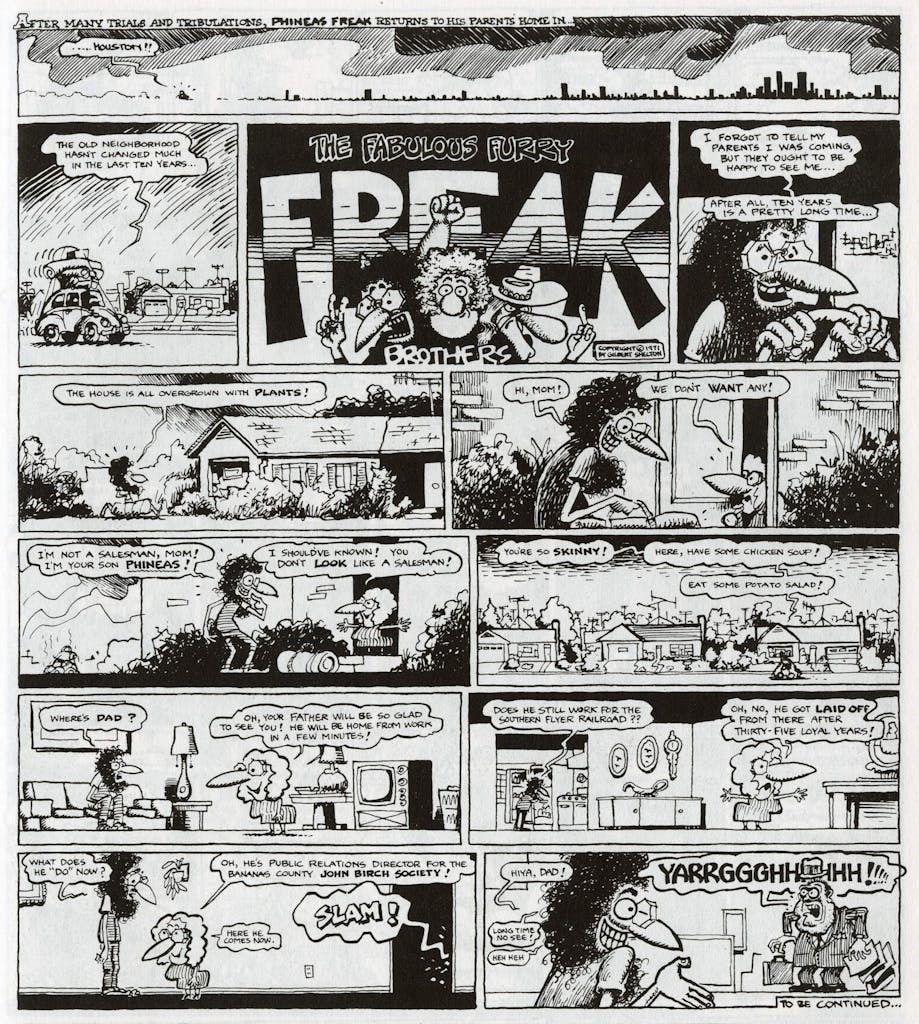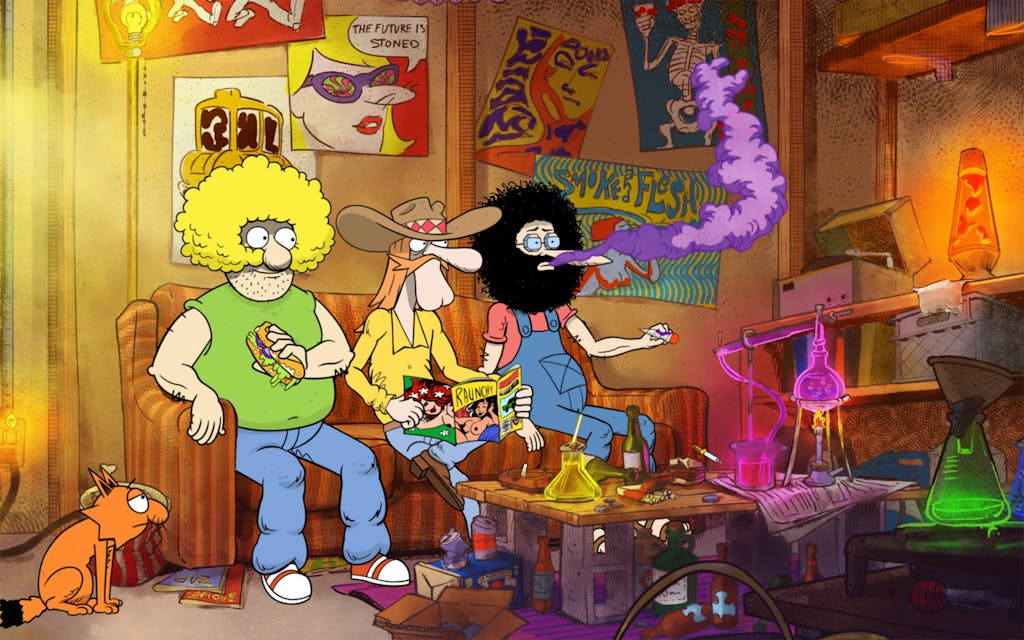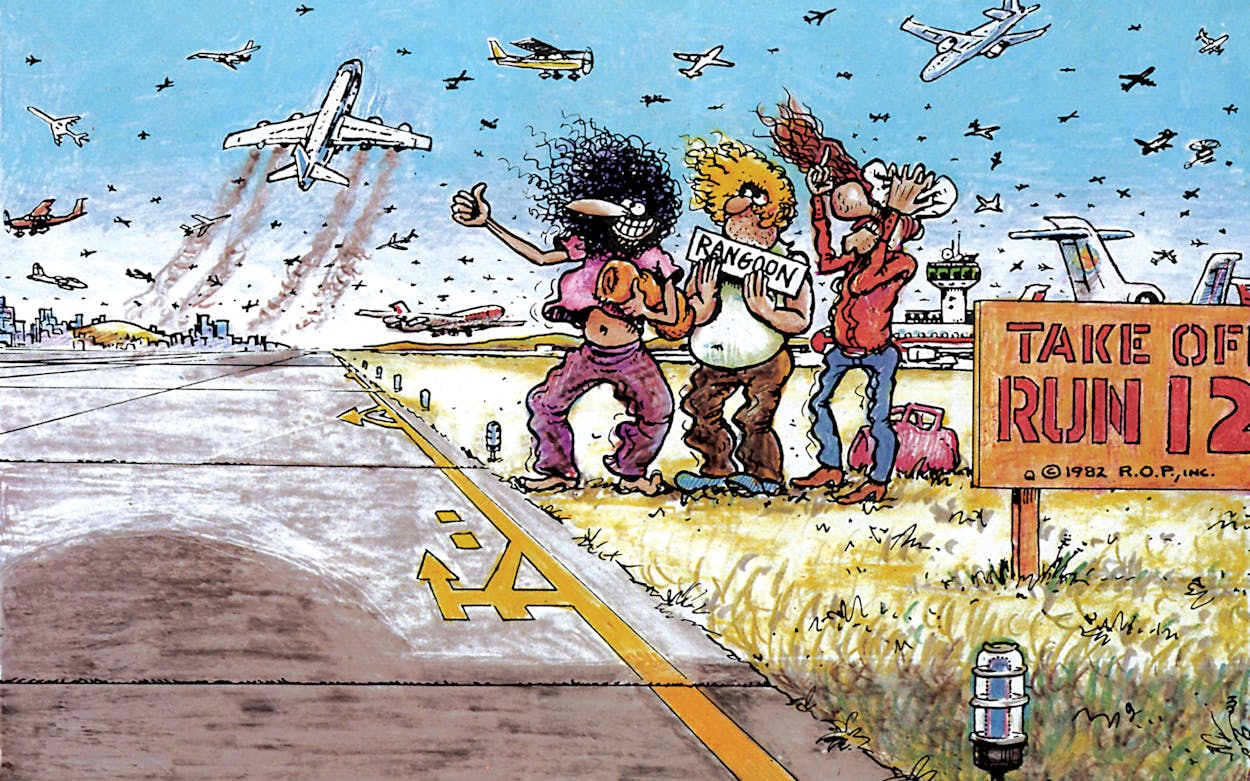San Francisco is the city most often associated with the underground comix movement of the sixties and seventies, the place where underground artists found it easiest to let their freak flag fly in pen and ink. (The “x” in “comix” was an act of rebellion that set the underground crew apart from, say, makers of superhero fare.) The scattershot new animated TV show The Freak Brothers, based on Gilbert Shelton’s canonical comic The Fabulous Furry Freak Brothers, is rooted in the City by the Bay, every bit as much as its source material is. But Texas, and Austin in particular, also played a key role in the birth of this still-influential scene.
True heads know that the three Freak Brothers—Phineas, Freewheelin’ Franklin, and Fat Freddy—were born in Austin in 1967. Shelton wrote cartoons for an underground weekly called The Rag, and hung out with famous or soon-to-be-famous authors including Billy Lee Brammer, Bud Shrake, Jan Reid, and Gary Cartwright. He also worked on the University of Texas at Austin student humor magazine, The Texas Ranger, with editors Bill Helmer (a future Texas Monthly scribe), Lynn Ashby, and Hugh Lowe.
Born in Dallas in 1940, Shelton studied social sciences and art at UT-Austin, where he fell in with a cadre of like-minded comix artists. His buddies included fellow cartoonists Jack “Jaxon” Jackson; Tony Bell, with whom Shelton created the superhero parody Wonder Wart-Hog; and Frank Stack (a.k.a. Foolbert Sturgeon). This crew hung out in the Student Union cafeteria and the venerable Austin restaurant Scholz Garten. They wrote and they drew. They were Texas freaks, a more exotic breed than the ubiquitous San Francisco freaks, and they were a vital part of the early underground comix scene. Indeed, it’s impossible to imagine that scene without them.
“We were Texas hippies, a proud but pitiful bunch,” Shelton emails from his home in Paris, France. “The characters we created are more or less autobiographical, as fiction tends to be.”
Shelton actually conceived of the Freak Brothers to help promote a film. In 1967, he was the art director for a famed Congress Avenue music venue, the Vulcan Gas Company. The Vulcan also showed films, including a five-minute short called Texas Hippies March on the Capitol. Shelton’s promo poster, featuring the Freak Brothers, proved more popular than the film it was promoting, and the Brothers soon had their own strip in The Rag (Wonder Wart-Hog had been on the scene since 1962).
Before long, Shelton answered the siren song of San Francisco, where, in 1969, he founded Rip Off Press with three other Texas expat cartoonists: Jackson, Fred Todd, and Dave Moriarty. This is where Shelton, and his Freak Brothers, came into their own.

The Freak Brothers were mercilessly funny when many of their contemporaries were paranoid and dark. Three bachelors sharing a San Francisco flat with an army of determined cockroaches and Fat Freddy’s sardonic cat, who eventually got his own spinoff, the Freaks were feckless faces of hippie culture, determined to get stoned however and whenever possible. Fat Freddy, the dimmest and sweetest of the three, was usually the one assigned to go score, even though his penchant for getting ripped off was well known among his mates. Phineas—his face covered by a burst of black hair, his long nose shaped like a joint—was the politically aware philosopher cynic. Freewheelin’ Franklin, cowboy hat perched atop his head, bulbous nose, and long chin, represented the country freaks of the world. The show reproduces these characters adequately enough; it knows their basic traits, even if it doesn’t give them much depth.
I got to know the Freak Brothers early in life. Probably too early. Growing up in Berkeley with counterculture parents who bought the comic book regularly, I was drawn to the characters on a purely visual level. I had no idea what the sayings meant—such as “Dope will get you through times of no money better than money will get you through times of no dope” (so sayeth Freewheelin’ Franklin)—but I didn’t really care. I especially liked the minor characters, including Country Cowfreak, the pipe-smoking, pencil-neck weirdo who grew weed on his farm; Notorious Norbert the Nark, thankfully too dumb to bust anyone; and the rogues’ gallery of sweaty, thick-necked blue-collar establishment figures who could have stumbled out of a George Wallace rally. Shelton is a gifted visual artist; his creations have defining, exaggerated physical characteristics that pop off the page in a visceral way. The show’s aesthetic is slicker, and a lot less grimy, less like a doped-out fever dream.
Shelton, now 81, moved to Barcelona with his wife, literary agent Lora Fountain, in the early eighties; they also lived in London. And then it was on to Paris, where they have lived since 1984. They originally planned a short publicity tour in Paris, but they liked it so much they stayed (much as another underground comix giant, Robert Crumb, moved to France with his family in 1991).
“Comic books are seen with much more respect in Europe than the U.S.A.,” Shelton said. You can purchase Freak Brothers comics and newer Shelton works from the English publisher Knockabout Comix, which also publishes the likes of Alan Moore (Watchmen; V for Vendetta). There’s been talk of a Freak Brothers movie over the years, but nothing ever got off the ground. And now . . . the TV show.

Now streaming on Tubi, the new The Freak Brothers, whose lead characters remain fabulous and furry, are a mixed bag. The show has some top-level voice talent, including Midland’s own Woody Harrelson as Freewheelin’ Franklin, Pete Davidson as Phineas, John Goodman as Fat Freddy, and Tiffany Haddish as Fat Freddy’s cat. The premise has promise: back in 1969, the Brothers went to Woodstock, where they procured some killer THC juice from a swami, lit up in their San Francisco basement, and promptly fell asleep for fifty years (good stuff, man).
All of this sets up a kind of future shock, except the future is our present. When the high finally wears off, our characters are in for a rude awakening: San Francisco is now a rich person’s playground that prices out artists and bohemians like them. The Brothers have never seen a cellphone, much less used one. The idea of marijuana dispensaries, though, seems too good to be true—if only the regulations weren’t so strict.
There’s potential in this Rip Van Winkle act. But a lot of it is squandered on aggressively scatological humor, including an entire episode dedicated to a pot plant growing out of Fat Freddy’s anus. As you might guess, that gets old fast. It’s almost as if the Freak Brothers team is scared to be as smart as its source material, or it can’t find a better way to be dumb than poop jokes. There’s something lazy about the show, a sense that all you need to do is roll out the boys, tell a few weed jokes, and get some easy laughs.
What does Shelton think of the show? That’s an excellent question. He hasn’t seen it, though he says that choice isn’t personal: “I don’t watch teevee cartoons myself,” he writes. There’s something refreshing about this in the old “kill your television” sense. Do we really want our old rebels camping out in front of the boob tube? Do we expect architects of the counterculture to study what the latest streaming service has done with their work? No, that’s for us consumers and pundits.
Still, the Freak Brothers have come a long way since the days of Texas Hippies March on the Capitol. Another generation, one that does binge-watch TV, can now indulge in a (bastardized) blast from the past, and perhaps even be inspired to read the original comix. The collections, and even some of the originals, are an Amazon click away. Just remember: the Freak Brothers may have found their way to San Francisco, as so many freaks did, but they were born right here in Texas.
- More About:
- Film & TV
- Books
- Television
- Austin






